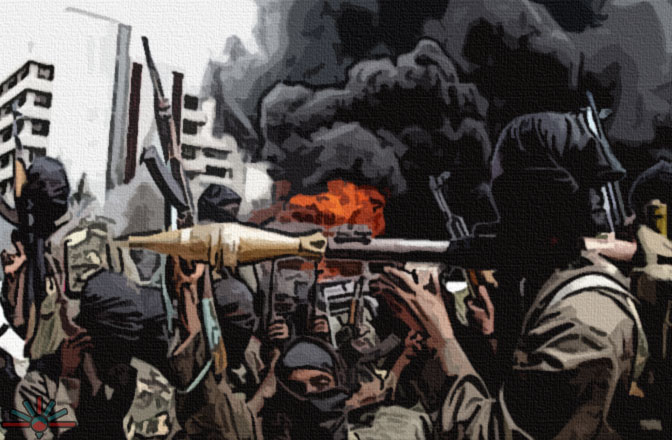 Nearly a year ago last May, the mercurial leader of Boko Haram announced the fate of 276 schoolgirls that he and his men kidnapped from a secondary school in Chibok, Nigeria. Standing in front of a video camera and tugging at a red hat, Abubakar Shekau laughed as he read from a prepared statement. “I took the girls and I will sell them off,” he declared. “There is a market for selling girls.”
Nearly a year ago last May, the mercurial leader of Boko Haram announced the fate of 276 schoolgirls that he and his men kidnapped from a secondary school in Chibok, Nigeria. Standing in front of a video camera and tugging at a red hat, Abubakar Shekau laughed as he read from a prepared statement. “I took the girls and I will sell them off,” he declared. “There is a market for selling girls.”
Shekau’s chilling announcement startled many observers in the West. But as archaeologist Scott MacEachern of Bowdoin College in Brunswick, Maine, reported in a paper presented in April at the Society for American Archaeology meetings in San Francisco, the proposed sale of the girls came as little surprise to people living along the northern Nigeria-Cameroon border. For centuries, a local slave trade bought and sold captives with impunity, and little seemed to have changed. “The slave raiders are back,” the modern inhabitants told MacEachern.
Boko Haram originated as an Islamic sect in the northeastern Nigerian city of Maiduguri. Its heavily armed fighters currently control large chunks of the Nigerian state of Borno, as well as parts of northern Cameroon, Chad and Niger. Western analysts have generally traced the origins of the group to an incendiary blend of two radical strains of Sunni Islam: the Salafi and Wahhabi movements. But MacEachern’s studies shed new light on Boko Haram, strongly suggesting that the terrorist organization has absorbed ancient traditions of violence along the northern Nigeria-Cameroon border.
As early as the medieval period, notes MacEachern, this frontier had a reputation for mayhem. Around 1457 A.D., for example, the Italian cartographer Fra Mauro noted on his map of the world that the area was infested with thieves and bandits. And MacEachern’s archaeological research backs up this contention. The region’s Mandara Mountains, he says, have long been densely populated, but they lay just beyond the boundaries of important historic states or empires, such as Bornu and Bagirmi. In this lawless land, the ruthless grew rich from preying on their neighbors. MacEachern and his colleagues found several ancient sites dating between the 15th and the 17th centuries containing bits of costly goods such as iron chainmail and carnelian beads—obtained, in all likelihood, from Africa’s long-distance slave trade.
“One of the major resources in this region was other human beings,” says MacEachern, and the only way to lay hands on large numbers of captives “involved violence.” So profitable and entrenched did this trade become that it survived well into the 1920s and 1930s.
Today, violence persists in the region. Jobs are scarce and young men without prospects are unable to find a wife. As a result, many young males are driven into criminal activities, such as smuggling cheap gas from oil-rich Nigeria into Cameroon. “You see guys on motorcycles with a lot of plastic containers filled with gas,” says MacEachern. It doesn’t look like a dangerous way to earn a living, but the illegal economy is littered with perils. The rivalries between gas smugglers is much like the competition between drug trafficking networks in northern Mexico today. As a result, “there are areas that are no-go zones,” MacEachern notes.
But the urban founders of Boko Haram had no compunction about venturing into the region. As jihadists, they sought to bring down Nigeria’s government and institute sharia law. The best tactic, they believed, was to retreat to the frontier, and to build up their forces there so they could capture the capital. In the northeastern countryside, they began recruiting followers, including the young smugglers and others without prospects. “It’s a zone of great violence and danger but also a zone of wealth and opportunity,” says MacEachern.
The archaeologist was recently invited to give a talk at the State Department on his research. He saw many in the room taking notes, but he was unable to provide any answers for a question that troubled many: the whereabouts of the kidnapped school girls. History offers few clues, he says. “They could be just about anywhere now in the Lake Chad basin.”
__________
Heather Pringle was one of LWON’s founders. She’s since gone off and helped to launch another online entity, the extremely impressive Hakai magazine. She freelances regularly for National Geographic, is a contributing correspondent for Science magazine, and a contributing editor to Archaeology magazine. We’re delighted and honored to have her back and wish she’d visit more often.
__________
Picture credit: Boko Haram – AK Rockefeller, via Wikimedia